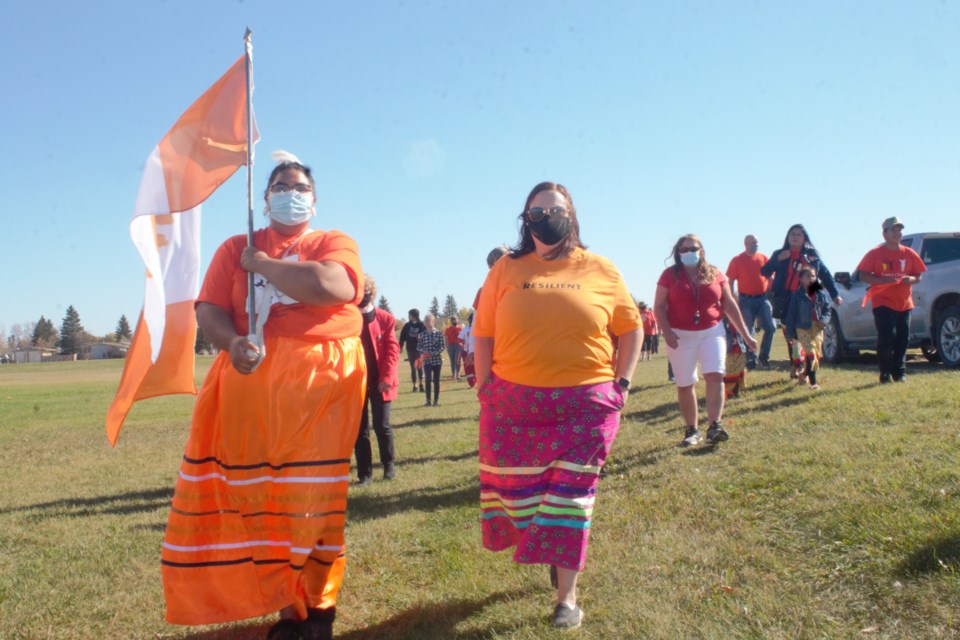MELFORT — Melfort & Unit Comprehensive Collegiate’s track was filled with community members of various ages, each connected by six feet of orange ribbon as they marked the first National Day for Truth and Reconciliation.
Gailmarie Anderson, one of the organizers with the city, said the event served to honour the survivors of residential schools and those who didn’t make it back, in order to learn and move forward.
“I think it’s important for the community to recognize the National Day for Truth and Reconciliation and [that] we’re all in this together,” Anderson said. “The event today shows that we have cooperation across the nations and we are building our relationships and taking them to a new level.”
Riley Burns, an elder from James Smith First Nation and a survivor of Gordon's Indian Residential School, spoke to the crowd gathered around the track, which transitioned into a round dance once he finished.
“Only the people that went through it will understand, that are still alive to tell the story. You live it from the time you get up until the time you go to bed, and those are some hard times,” Burns said to media after the event.
“When you got in trouble it was some of the hardest treatment you got – a strap. Not only on your hands, but all over your body. Sometimes it’s pretty hard to take when they start hitting you on the back, so that was the hard part of it to take those types of treatments from the staff.”
After the round dance, the crowd was led by Tara Aisaican’s flag toward City Hall.
Aisaican’s flag has been raised at a number of reconciliation events after it was unveiled in July by the Federation of Sovereign Indigenous Nations. It has two orange stripes at both ends and a white center with the handprint of Aisaican’s daughter Ada Jo-Lee Scott.
Deanndra Stonestand carried the flag throughout the round dance and the duration of the walk to City Hall.
Stonestand was also responsible for organizing the memorial outside City Hall earlier this summer after the Tk'emlups te Secwepemc First Nation found 215 bodies buried at the Kamloops residential school. The memorial was recreated outside City Hall for Sept. 30.
“The meaning of this flag is different than a normal ‘every child matters’ one. This one, to me, it symbolizes the true history of Canada,” Stonestand said.
“People look in Canada in a way like it’s free, in reality, I hate to say it, but it’s built on genocide and it has been for a long time. Now that the flag is changed people are starting to recognize it more. It just kind of proves people are starting to learn and people are starting to listen.”
In her opinion the main thing to take away during the day is to listen.
“If you’re not Indigenous, then listen. Just educate yourself. Education is probably the biggest key in reconciliation.”
Both the National Day for Truth and Reconciliation and Orange Shirt Day take place on Sept. 30.
Orange Shirt Day is an Indigenous-led grassroots commemorative day that honours the children who survived Indian Residential Schools and remembers those who did not. The day began in 2013, telling the story of a residential school survivor who had her shiny new orange shirt taken away from her upon arriving at St. Joseph Mission residential school.
The National Day for Truth and Reconciliation is a federal statutory holiday made by Parliament on June 3, 2021, as a response to the Truth and Reconciliation Commission’s Call to Action 80, which called for a federal statutory day of commemoration.
Former Residential School students can call 1-866-925-4419 for emotional crisis referral services and information on other health supports from the Government of Canada. Indigenous peoples across Canada can also go to The Hope for Wellness Help Line 24 hours a day, seven days a week for counselling and crisis intervention 1-855-242-3310.



